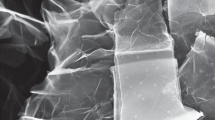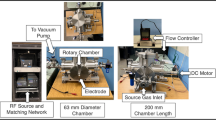Abstract
Solution plasma is applied to graphite and thermally reduced graphite oxide in ambient conditions in order to improve their dispersion. Changes in morphology, oxygen functional groups, defects, decomposition temperatures, oxygen to carbon atomic ratio, conductivity, stability, and degree of dispersion are systematically investigated by using scanning electron microscopy, Fourier-transform infrared spectroscopy, Raman spectroscopy, Thermogravimetric analysis, X-ray photoelectron spectroscopy, Zeta potential analyzers, and ultraviolet–visible spectrophotometry. Dramatic enhancement of the dispersion after the simple plasma treatment is introduced without evident change of conductivities. This simple, easy, economical, and eco-friendly plasma method could functionalize and reform material efficiently in many application fields.






Similar content being viewed by others
References
Balandin AA, Ghosh S, Bao W, Calizo I, Teweldebrhan D, Miao F, Lau CN (2008) Superior thermal conductivity of single-layer graphene. Nano Lett 8:902–907
Bolotin KI, Sikes KJ, Jiang Z, Klima M, Fudenberg G, Hone J, Kim P, Stormer HL (2008) Ultrahigh electron mobility in suspended graphene. Solid State Commun 146:351–355
Lee C, Wei X, Kysar JW, Hone J (2008) Measurement of the elastic properties and intrinsic strength of monolayer graphene. Science 321:385–388
Stoller MD, Park S, Zhu Y, An J, Ruoff RS (2008) Graphene-based ultracapacitors. Nano Lett 8:3498–3502
Geim AK, Novoselov KS (2007) The rise of graphene. Nat Mater 6:183–191
Avouris P, Dimitrakopoulos C (2012) Graphene: synthesis and applications. Mater Today 15:86–97
Bonaccorso F, Colombo L, Yu G, Stoller M, Ferrari AC, Ruoff RS, Pellegrini V (2015) Graphene, related two-dimensional crystals, and hybrid systems for energy conversion and storage. Science 347:124650-1–124650-9
Park S, Ruoff RS (2009) Chemical methods for the production of graphenes. Nat Nano 4:217–224
Dreyer DR, Park S, Bielawski CW, Ruoff RS (2010) The chemistry of graphene oxide. Chem Soc Rev 39:228–240
Sharma D, Kanchi S, Sabela MI, Bisetty K (2016) Insight into the biosensing of graphene oxide: present and future prospects. Arab J Chem 9:238–261
Lee J, Kim J, Kim S, Min DH (2016) Biosensors based on graphene oxide and its biomedical application. Adv Drug Deliver Rev 105(Part B):275–281
Lee MW, Kim HY, Yoon H, Kim J, Suh JS (2016) Fabrication of dispersible graphene flakes using thermal plasma jet and their thin films for solar cells. Carbon 106:48–55
Seiko U, Koichi S, Asami O, Noboru T, Tatsurou N, Masanao E, Naoki M (2014) Improvement of solvent affinity for graphene derivates by solution plasma process. Jpn J Appl Phys 53:01AD05-1–01AD05-4
Sun DW (2005) Emerging technologies for food processing. Elsevier, Laguna Hills, p 309–409
Qiang C, Junshuai L, Yongfeng L (2015) A review of plasma-liquid interactions for nanomaterial synthesis. J Phys D Appl Phys 48:424005–424030
Mohamed MH, Cedric P, Petr L, Jan B (2016) Atmospheric plasma generates oxygen atoms as oxidizing species in aqueous solutions. J Phys D Appl Phys 49:404002. https://doi.org/10.1088/0022-3727/49/40/404002
Kim HJ, Yang CS, Jeong HK (2016) Electrochemical properties of modified highly ordered pyrolytic graphite by using ambient plasma. Chem Phys Lett 644:288–291
Theophile NJ, Jeong HK (2016) Reduction of graphite oxide by using an atmospheric pressure plasma. New Phys Sae Mulli 66:637–641
Tran MH, Yang CS, Jeong HK (2016) Fast and economical reduction of poly (sodium 4-styrene sulfonate) graphite oxide film by plasma. Electrochim Acta 196:769–774
Jeong HK, Lee YP, Lahaye RJWE, Park MH, An KH, Kim IJ, Yang CW, Park CY, Ruoff RS (2008) Evidence of graphitic AB stacking order of graphite oxides. J Am Chem Soc 130:1362–1366
Tran MH, Jeong HK (2015) One-pot synthesis of graphene/glucose/nickel oxide composite for the supercapacitor application. Electrochim Acta 180:679–686
Tran MH, Jeong HK (2017) Comparison of ruthenium composites with thermally reduced graphene and activated carbon for supercapacitor applications. J Mater Sci Mater Electron 28:7969–7975. https://doi.org/10.1007/s10854-017-6500-y
Eswaraiah V, Jyothirmayee A, Sasidharannair S, Ramaprabhu S (2011) Top down method for synthesis of highly conducting graphene by exfoliation of graphite oxide using focused solar radiation. J Mat Chem 21:6800–6803
Jeong HK, Lee YP, Jin MH, Kim ES, Bae JJ, Lee YH (2009) Thermal stability of graphite oxide. Chem Phys Lett 470:255–258
Hsiao MC, Ma CCM, Chiang JC, Ho KK, Chou TY, Xie X, Tsai CH, Chang CK et al (2013) Thermally conductive and electrically insulating epoxy nanocomposites with thermal reduced graphene oxide-silica hybrid nanosheets. Nanoscale 5:5863–5871
Zhu C, Guo S, Fang Y, Dong S (2010) Reducing sugar: new functional molecules for the green synthesis of graphene oxide nanosheets. ACS Nano 4:2429–2437
Ferrari AC, Meyer JC, Scardaci C, Lazzeri M, Mauri F, Piscanec S, Jiang D, Novoselov KS et al (2006) Raman spectrum of graphene and graphene layers. Phys Rev Lett 97:187401-1–187401-4
Socrates G (2001) Infrared characteristic group frequencies tables and charts. Wiley, Chichester, pp 94–99
Gao R, Hu N, Yang Z, Zhu Q, Chai J, Su Y, Zhang L, Zhang Y (2013) Paper-like graphene-Ag composite films with enhanced mechanical and electrical properties. Nanoscale Res Lett 8:32–39
Jeong HK, Colakerol L, Jin MH, Glans PA, Smith KE, Lee YH (2008) Unocuppied electronic states in graphite oxide. Chem Phys Lett 460:499–502
Grzyb B, Gryglewicz S, Sliwak A, Diez N, Machnikowski J, Gryglewicz G (2016) Guanidine, amitrole and imidazole as nitrogen dopants for the synthesis of N-graphenes. RSC Adv 6:15782–15787
Jeong HK, Noh HJ, Kim JY, Jin MH, Park CY, Lee YH (2008) X-ray absorption spectroscopy of graphite oxide. Erophys Lett 82:67001-1–67004-5
Du D, Li P, Ouyang J (2015) Nitrogen-doped reduced graphene oxide prepared by simultaneous thermal reduction and nitrogen doping of graphene oxide in air and its application as an electrocatalyst. ACS Appl Mater Interface 7:26952–26958
Konkena B, Vasudevan S (2012) Understanding aqueous dispersibility of graphene oxide and reduced graphene oxide through pKa measurements. J Phys Chem Lett 3:867–872
Acknowledgements
This work was supported by Basic Science Research Program through the National Research Foundation of Korea (NRF-2016R1D1A3B04931018).
Author information
Authors and Affiliations
Corresponding author
Rights and permissions
About this article
Cite this article
Tran, MH., Jeong, H.K. Improved dispersion of graphite derivatives by solution plasma. J Mater Sci 53, 3388–3397 (2018). https://doi.org/10.1007/s10853-017-1799-6
Received:
Accepted:
Published:
Issue Date:
DOI: https://doi.org/10.1007/s10853-017-1799-6




